Turtles are easy to love.
They are cute, small and can live in water and on land.
These aquatic pets are lifelong companions and will provide you with lots of fun moments.
But with over 300 types of turtles in the world which one do you choose?
Some are cute and easy to care for so are great a choice for beginners. Other types grow very big and are difficult to care for.
Our list of 33 turtle breeds includes just species that are cute and easy for beginners! Keep reading to find one that is right for you.
33. European Pond Turtle
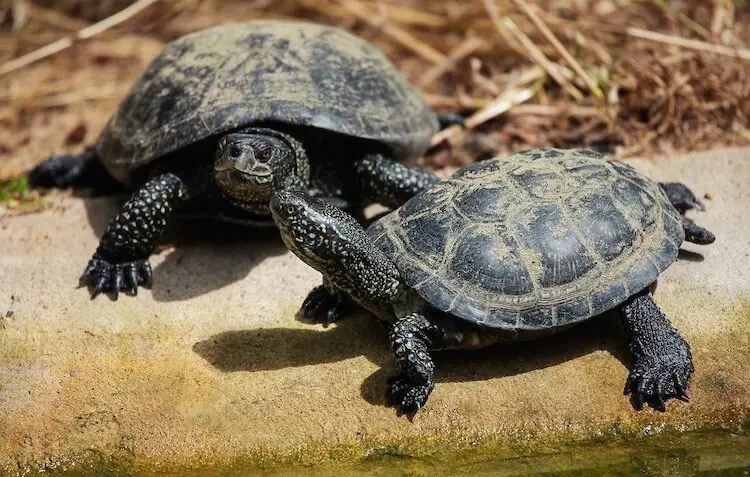
The European Pond is one of the most wide-spread pond turtles in Europe.
These guys live in freshwater ponds so they need lots of water and a place to sit.
At home they can live in a protected backyard pond or indoors in a 100-gallon tank.
They like basking on water edges (with temperatures around 95℉) as well as hunting for food. They enjoy eating frogs, fish and insect snacks.
This species is normally seven inches long and has a smooth black shell that is speckled with yellow spots.
What makes the European Pond a great pet turtle is its hardiness and ease of care!
| Vital Facts |
|---|
| Price: $100 to $300 |
| Tank Size: 100-gallon |
| Size: 5 to 15 inches long |
| Lifespan: 40 to 60 years |
32. Bog Turtle
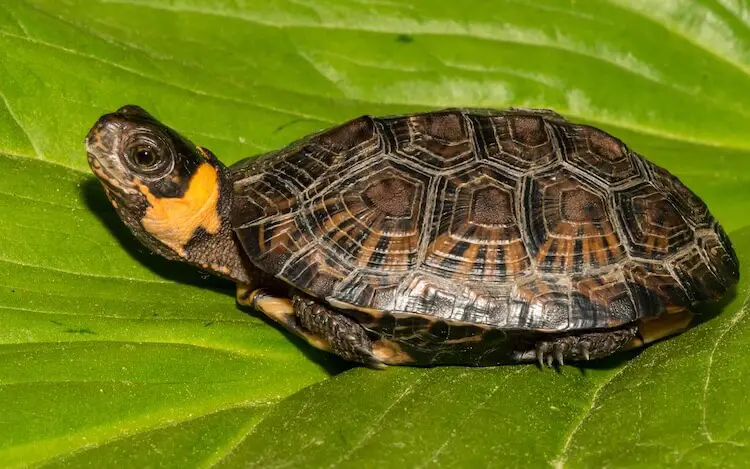
The Bog Turtle is another pond species from the same family as the European Pond (#33) (Emydidae Family).
You can find this type near spring-fed bogs, swamps and marshes in eastern United States.
Some are also found grazing in wet fields alongside cattle.
If you want a pet turtle that stays small then this breed is perfect.
Little Bogs only grow to four inches and are one of the smallest turtles in the world! Beginners love them for their cute size.
They are usually brown with a yellow band around their neck.
These guys live well in a 40-gallon tank with water at 72℉ to 80℉ and a basking area of 85℉ to 90℉.
| Vital Facts |
|---|
| Price: $250 to $450 |
| Tank Size: 40-gallon |
| Size: 4 inches long |
| Lifespan: 20 to 30 years |
31. Loggerhead Musk Turtle
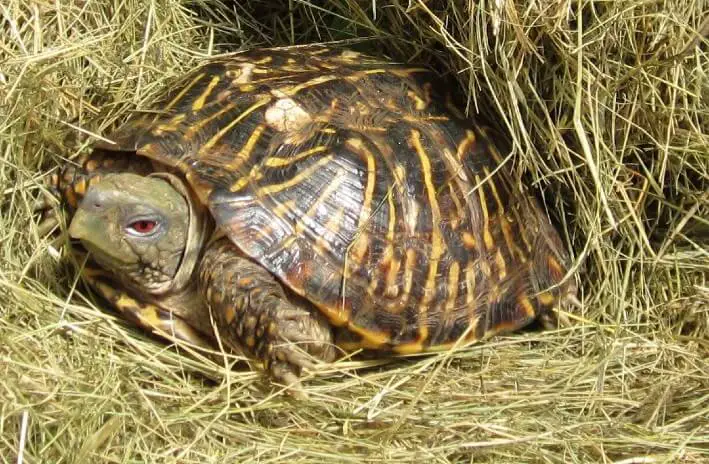
Loggerhead Turtles are native to the southeastern United States.
They are commonly found near rivers, springs, ponds and even man-made canals.
These little guys often have brown shells with darker brown spots. Their skin is gray-brown and is often spotted.
These reptiles love the water. They thrive in habitats where they can dive and interact with live plants.
Loggerheads are great for beginners because they are small, hardy and have fun personalities! They are very outgoing and grow to know their owners.
They also get along well with other types of turtles so they are great if you want more than one pet.
| Vital Facts |
|---|
| Price: $35 to $50 |
| Tank Size: 40-gallon |
| Size: 3 to 5 inches long |
| Lifespan: 20 years |
30. Pink Belly Sideneck Turtle
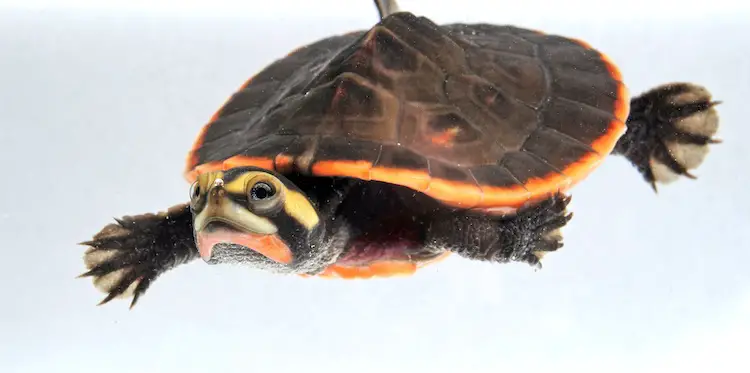
This colorful turtle is native to the islands and rivers of Australia and New Guinea.
Beginners love these turtles for their cute and unique appearance.
Pink Bellies have black shells that contrast with their bright orange-pink undersides. Their black heads normally have yellow eye markings too.
Another thing that makes this species unique is the way they retract their heads into their shells.
Like most turtles they enjoy swimming and basking. Most of the time they are very active in their tank.
They should live in a 60-gallon aquarium with temperatures around 75°F and a basking area around 85°F.
| Vital Facts |
|---|
| Price: $100 to $500 |
| Tank Size: 60-gallon |
| Size: 8 to 9 inches long |
| Lifespan: 30 to 50 years |
29. Ouachita Map Turtle
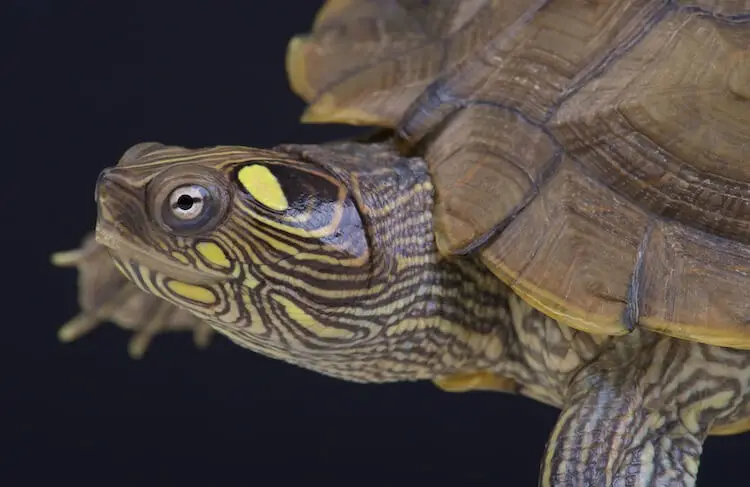
The Ouachita Map Turtle is typically brown with yellow neck markings.
They have big, flat webbed feet for swimming. They like strong, clear river waters and are commonly found along the Mississippi and Ouachita Rivers.
This species has a range from the midwestern United States to the north east coast.
When first discovered they were thought to be a subspecies of the False Map Turtle (#11). They are now recognized as a subspecies of the Graptemys ouachitensis species.
Males remain very small as adults and only grow four inches long!
Surprisingly they are less popular than other types of map turtles but they are hardy, fun and have very easy care requirements.
| Vital Facts |
|---|
| Price: $40 to $100 |
| Tank Size: 50-gallon |
| Size: 3 to 10 inches long |
| Lifespan: 30 to 50 years |
28. Northern Map Turtle
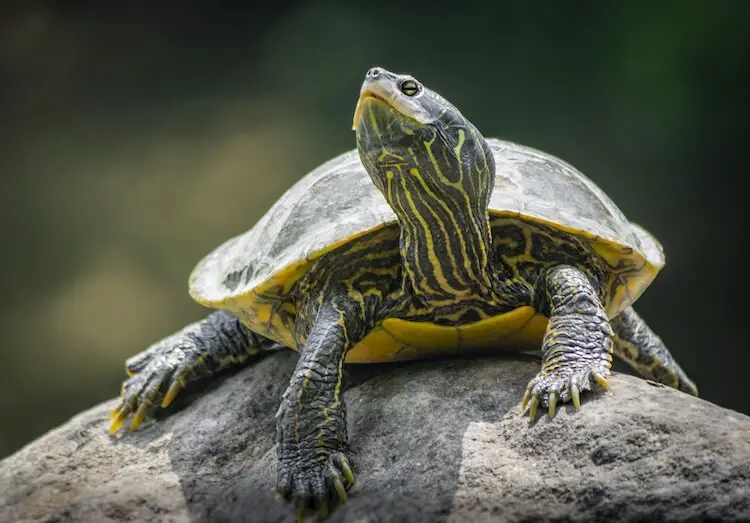
The Northern Map Turtle is also known as the Common Map species.
They are just as easy to care for as the Ouachita Map breed (#29) but are more popular pets!
Northern Maps have a very long range along the eastern side of North America.
They are commonly found near the Great Lakes, Susquehanna River system, and St. Lawrence River Drainage.
Their skin has a yellow stripe pattern and their shells are typically solid brown. Males display much brighter colors than females.
These aquatic animals are hardy and easily bred in captivity.
Their needs are very well-known and they are a great turtle for beginners!
The Northern Map species does well in a 125-gallon tank with temperatures around 77℉ to 80℉.
| Vital Facts |
|---|
| Price: $40 to $100 |
| Tank Size: 125-gallon |
| Size: 4 to 11 inches long |
| Lifespan: 15 to 20 years |
27. Chinese Box Turtle
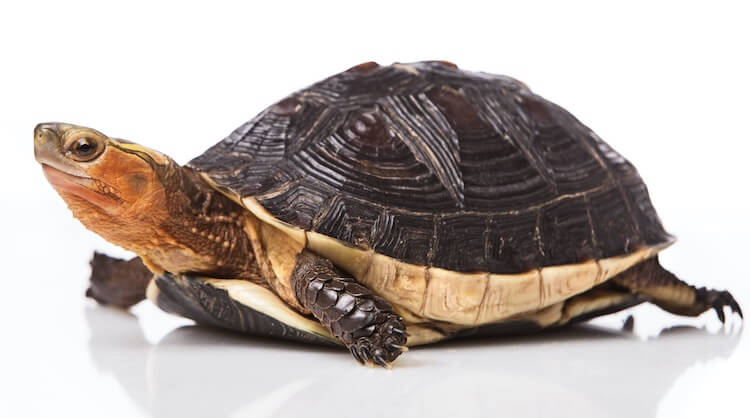
The Chinese Box Turtle is known as the Snake-Eating and Yellow-Margined Box Turtle.
Despite their misleading name they are not only found in China, but also Japan, Vietnam and Laos.
These animals are omnivorous but prefer a leafy green diet over insects. In captivity you can feed them vegetables, leafy greens and some protein.
Many box breeds make great pet turtles.
The Chinese Box is no exception!
They are not common pets but any dedicated beginner can care for one.
These turtles are more colorful than other box species and owners love them for their rarity.
Their shells are often dark brown and occasionally have red-brown patches. They have yellow heads and brown limbs and are quite a colorful pet.
Chinese Boxes can live happily in a 50-gallon aquarium with space to bask and swim.
| Vital Facts |
|---|
| Price: $150 to $700 |
| Tank Size: 50-gallon |
| Size: 8 inches long |
| Lifespan: 25 to 40 years |
26. Desert Box Turtle

The Desert Box is one of two subspecies of Terrapene ornata. The other type is the hugely popular Ornate Box Turtle (#6).
Desert Box Turtles are slightly more yellow in color than the Ornate and thrive in low humidity. This makes them the best choice for someone who lives in a dry environment. They do not need high humidity like most types of turtles.
This breed has a range throughout the southwestern and central United States.
The Desert Box is cheaper, smaller and more popular than its Chinese cousin (#27). However, it is not quite as bright and lives longer.
| Vital Facts |
|---|
| Price: $50 to $400 |
| Tank Size: 50-gallon |
| Size: 5 inches long |
| Lifespan: 30 to 40 years |
25. Mata Mata Turtle
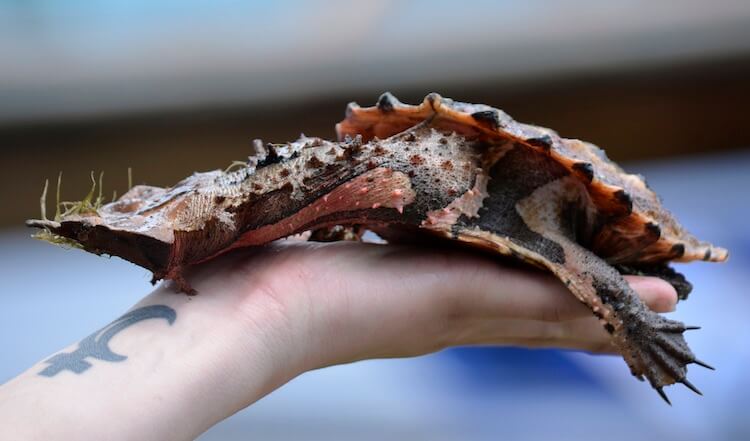
The Mata Mata species is perhaps one of the most unique looking in this list.
First time keepers love them for their one-of-a-kind appearance.
They are usually red, brown or green and the ridges on their shells resemble those of an alligator.
First time keepers should know this is one of the biggest pet turtles and can reach 1.5 feet.
The Mata Mata is not the best swimmer. They love stagnant, muddy water because it provides them with a place to hide. Most of their time is spent hiding near the bottom of the water and using their tube-like snout to breathe.
Unlike many on this list they are found in tropical regions.
This means they need tank water temperatures to reach over 90℉.
| Vital Facts |
|---|
| Price: $20 to $500 |
| Tank Size: 125-gallon |
| Size: 16 to 18 inches long |
| Lifespan: 30 years |
24. Chinese Softshell Turtle
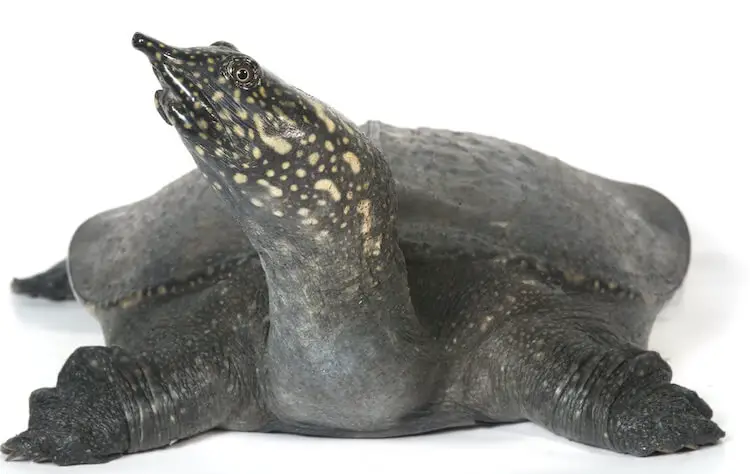
The Chinese Softshell Turtle is found throughout China, Thailand, Japan, Korea and Vietnam. As their name suggests they have a shell that is softer than the typical hard shell.
Similar to the Mata Mata (#25) breed the softshell is an incredibly unique type of turtle.
Their upkeep can be hard because of their soft shell. Any beginner will need to be dedicated to care for them and keep their tank clean.
Unlike the Mata Mata the softshell prefers to spend most of its time in the water.
They have a thin tube-like snout that is used for snorkeling.
Unfortunately this animal is commonly used for Chinese food and medicine, but you can also keep one as a pet.
| Vital Facts |
|---|
| Price: $40 to $50 |
| Tank Size: 125-gallon |
| Size: 11 to 13 inches long |
| Lifespan: 25+ years |
23. Florida Softshell Turtle
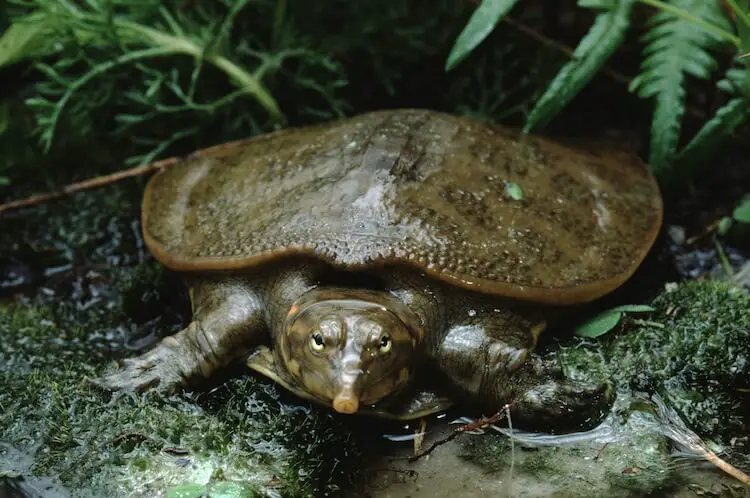
Florida Softshells are from the eastern United States – primarily the state of Florida.
All turtles with softshells have very similar care requirements.
What makes the Florida Softshell stand out is the wide size range between males and females:
- Males may stay small at about six inches – like the Ouachita Map (#29).
- Females can grow to over 1.5 feet!
It is recommended that beginners only purchase a male.
These turtles are intelligent, cute, and very fun.
Like the Chinese Softshell (#24) they need lots of water to swim in and a small basking area.
| Vital Facts |
|---|
| Price: $15 to $40 |
| Tank Size: 125-gallon |
| Size: 6 to 20 inches long |
| Lifespan: 30 years |
22. Spiny Softshell Turtle
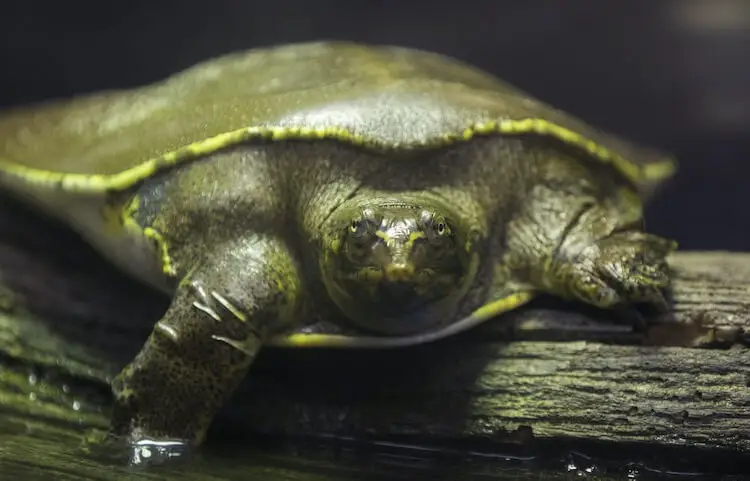
Spiny Softshells are found anywhere from central to northeastern United States and from southern Ontario to northern Mexico.
This breed is the last softshell turtle on our list.
Softshells are shy and skittish due to having less protection from their soft shell.
This turtle is considered to be threatened in the wild, but fortunately there are many captive-bred.
Spiny Softshells have a soft, flat shell and pointed nose. They are brown or green and have small spines lining part of their shell.
This spiny reptile prefers open waters and sandy resting places. They spend their days basking and foraging for food.
They eat various aquatic creatures including: insects, crayfish, and small fish.
A responsible beginner can care for this breed but they do have specific care requirements and are known to be shy.
| Vital Facts |
|---|
| Price: $10 to $50 |
| Tank Size: 125-gallon |
| Size: 5 to 30 inches long |
| Lifespan: 50 years |
21. Spotted Turtle
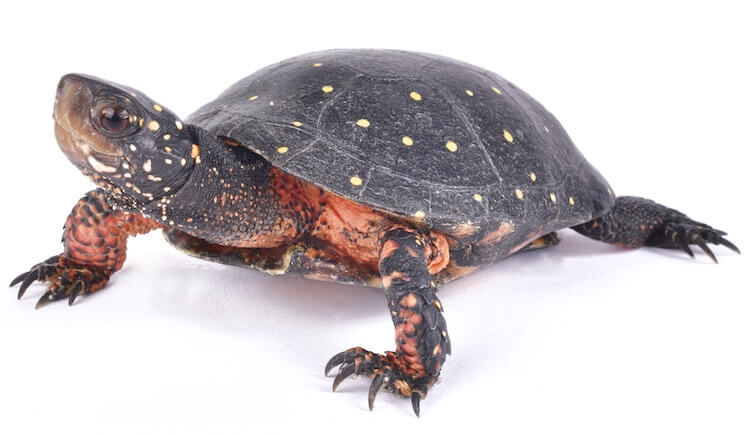
Spotted Turtles can be found in the northeastern United States and southeastern Canada.
The Spotted Turtle is a small, cute and eye-catching pet.
These little guys measure just five inches. They are usually black or dark brown with yellow-cream colored spots on their head and shell. Some have yellow, orange or red on their bellies too.
These turtles are even-tempered so they enjoy handling more than most.
They usually adjust well to captivity but are not strong swimmers and should be kept in a tank with shallow waters.
Any beginner is lucky to have this type.
| Vital Facts |
|---|
| Price: $75 to $100 |
| Tank Size: 75-gallon |
| Size: 3.5 to 5 inches long |
| Lifespan: 25 to 50 years |
20. Yellow Mud Turtle
Yellow Mud turtles are great for beginners.
They are not as unique as many pet turtles types in this list, but they are low-maintenance and hardy.
These little guys stay small too. Adults are under five inches in size.
Yellow Muds typically have yellow to light brown shells and bellies. Their cheeks and chin are a brighter shade of yellow than their shell.
These turtles are found in freshwater habitats in the midwestern United States.
They like spending time both on land and in water.
Yellow Muds are hardy and tolerant of many climates. If water starts to dry up, they bury themselves beneath the mud.
What makes this animal easy to care for is its diet. It will eat food (e.g. salmon, snails, shrimp and other invertebrates) both in and out of water.
They are a very friendly breed so you can have more than one.
| Vital Facts |
|---|
| Price: $100 to $400 |
| Tank Size: 40-gallon |
| Size: 4 to 5 inches long |
| Lifespan: 40 years |
19. Striped Mud Turtle
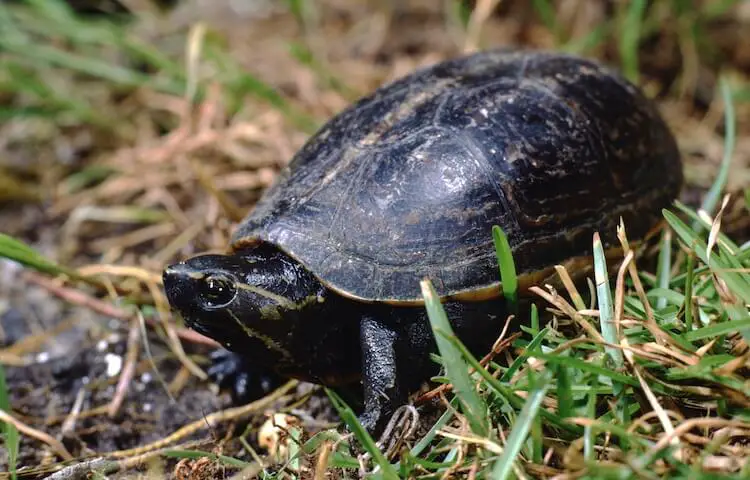
The Striped Mud is another type of turtle known for cooling down in the mud.
Appropriately named they have three light tan to cream colored stripes that run along the length of their shell. These stripes can be more difficult to see on some species.
Striped Mud turtles are found in the southeastern United States (from Virginia down to the tip of Florida).
Similar to the Yellow Mud (#20) this small turtle is just five inches and likes to swim.
Interestingly when they were first discovered it was thought they were only aquatic. It was later discovered they come up on land only occasionally. They should have a 20-gallon tank with plenty of water to swim around in.
This turtle is very low maintenance and great for beginners!
| Vital Facts |
|---|
| Price: $75 to $150 |
| Tank Size: 20-gallon |
| Size: 4 inches long |
| Lifespan: 50 years |
18. Diamondback Terrapin Turtle
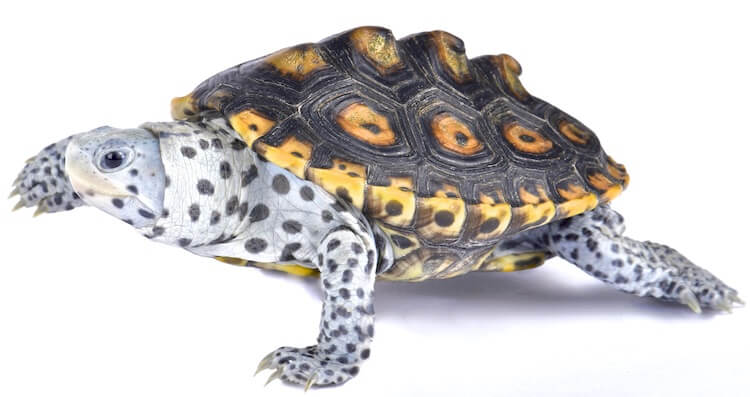
Diamondback Terrapins have some of the most interesting colors and patterns of any pet turtle.
Their shells are normally dark gray or black and have a rocky appearance. Their skin is usually light blue-gray in color with black spots.
They are often found in reedy marshes, lagoons and channels along the east coast of the United States.
What makes them unusual is that they live in saltwater but need fresh water to drink.
In the wild this species is timid but captive animals can be quite social after they adjust to their new environment.
They should live in 75-gallon tanks, but their water does not need to be heated like many types of turtles.
| Vital Facts |
|---|
| Price: $200 to $450 |
| Tank Size: 75-gallon |
| Size: 5 to 7.5 inches long |
| Lifespan: 25 to 40 years |
17. Reeve’s Turtle
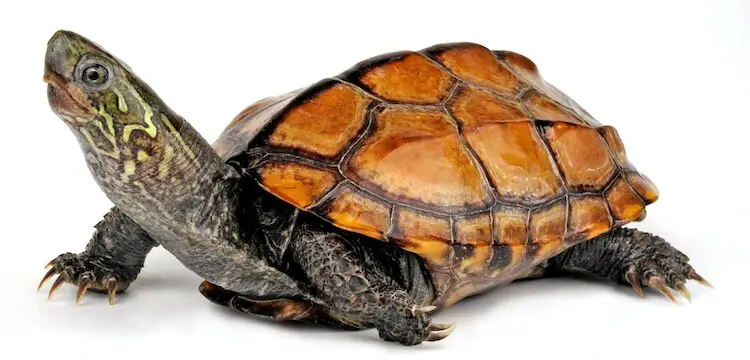
Reeve’s Turtles are also known as the Chinese Pond Turtle.
They live in slow-moving water with lots of vegetation and often have brown shells and brown-green skin.
This type can be found throughout China, Taiwan and Japan.
Reeve’s Turtles are not as colorful as others on this list. Owners love them for their charming personalities and small size.
They usually stay small as adults, though females can grow to be larger than males.
These aquatic animals are very active so live best in 50-gallon tanks with water depths that are 1.5 times their body size.
| Vital Facts |
|---|
| Price: $50 to $80 |
| Tank Size: 50-gallon |
| Size: 6 to 9 inches long |
| Lifespan: 10 to 20 years |
16. Ornate Wood Turtle (Painted)
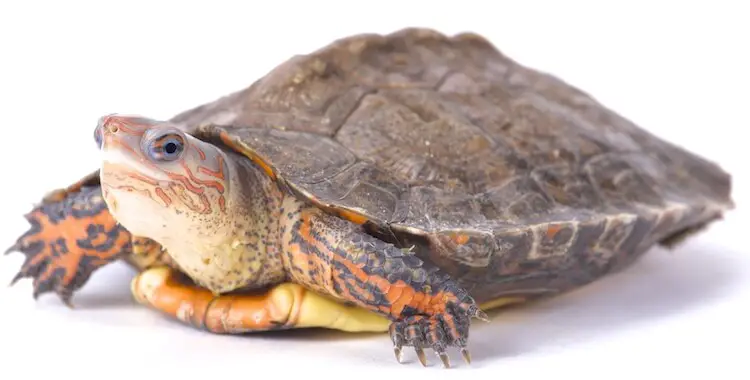
Ornate Wood Turtles are more terrestrial than most on this list! They are normally found in wooded areas close to streams or ponds.
Ornate species do best in a 55-gallon tank with very shallow water and lots of plants.
They have thin red lines on their face and parts of their shell. The rest of their shell is light brown with a center ridge. Their bellies are often yellow with patches of red.
This turtle is considered to be the most beautiful.
It is important that they are purchased from a captive breeder. When taken from the wild they have a hard time adjusting and normally die within one year.
| Vital Facts |
|---|
| Price: $100 to $175 |
| Tank Size: 55-gallon |
| Size: 5 to 8 inches long |
| Lifespan: 30+ years |
15. Razorback Musk Turtle
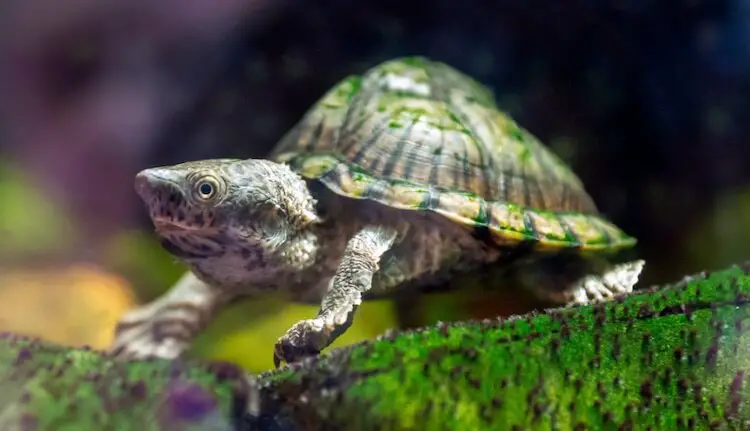
Razorback Musks are usually brown or green.
They have a characteristically high shell that creates a ridge along their spine.
The Razorback Musk is the second of three musk turtle breeds on this list.
Not much is known about the history of the Razorback Musk other than they were found in the southeastern United States.
Beginners love these turtles because they are small, unique and easy to care for.
They do not grow larger than six inches but are the largest of their type (i.e. musk turtles).
They are not aggressive or likely to bite you but they are shy so they should not be handled frequently. They will be less afraid if you watch them from afar.
| Vital Facts |
|---|
| Price: $25 to $100 |
| Tank Size: 30-gallon |
| Size: 5 to 6 inches long |
| Lifespan: 20 years |
14. Common Musk Turtle (Stinkpot)
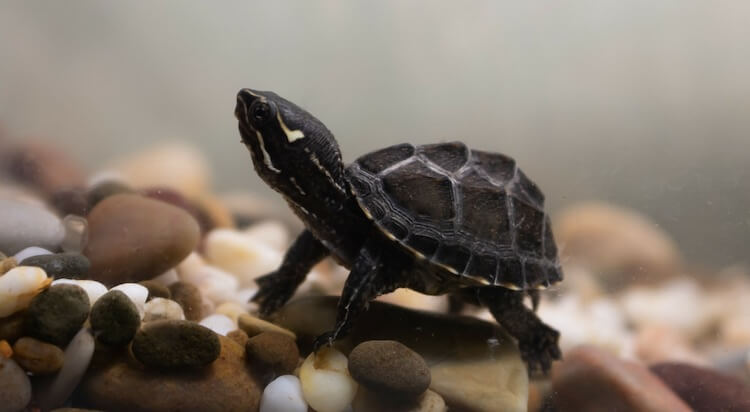
The Common Musk Turtle is one of the most abundant musk species in the United States. They can be found along the east coast to Kansas, Oklahoma and Texas.
Common Musks are smaller than the Razorback Musk (#15) and similar in size to the Loggerhead (#31).
Herpetologists love to keep this turtle because of their small size and ease of care.
Their shells are typically brown or black and very rounded. They have barbels on their chin and neck – this is unique to this subspecies.
They like shallow bodies of water where they can soak and occasionally come out to bask. Because of this they require lots of water in a 30-gallon tank and basking area.
Common Musks have interesting personalities and can be quite aggressive when threatened.
This animal is also known as the Stinkpot because of the musky smell they emit to keep away predators.
| Vital Facts |
|---|
| Price: $30 to $100 |
| Tank Size: 30-gallon |
| Size: 2 to 4.5 inches long |
| Lifespan: 30 years |
13. African Sideneck Turtle
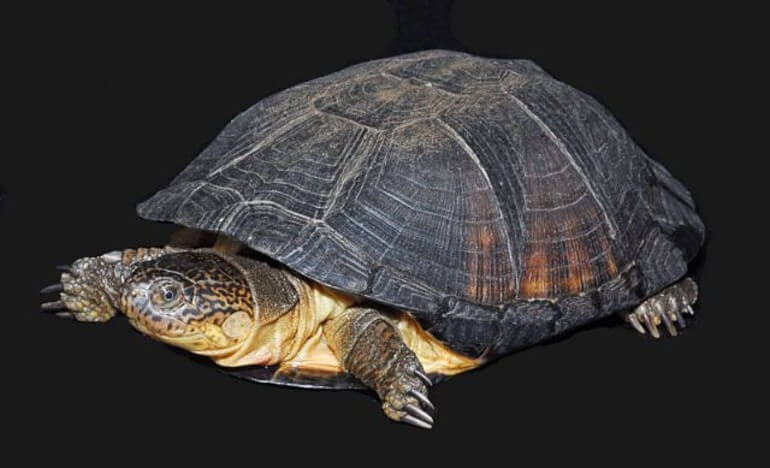
The African Sideneck lives happily in captivity and is easy to maintain.
They are commonly found in bodies of freshwater throughout Africa and Madagascar.
African Sidenecks’ mouths are curved upward in a “smile” making them a very cute turtle.
Like all sideneck species they are unique for having the ability to turn their heads sideways. They can also use their long necks to flip themselves over if they get stuck on their back.
This animal can be very entertaining to watch as they dive into the water and come up to bask.
| Vital Facts |
|---|
| Price: $50 to $100 |
| Tank Size: 75-gallon |
| Size: 7 to 12 inches long |
| Lifespan: 50 years |
12. Mississippi Map Turtle
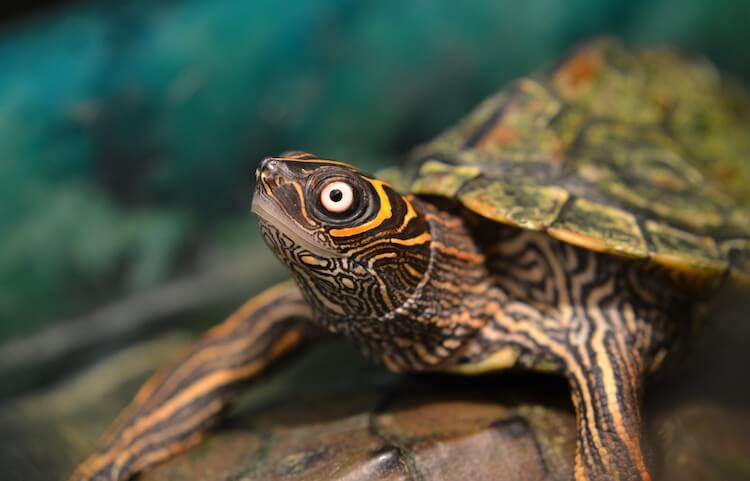
The Mississippi Map is one of two subspecies from the Graptemys pseudogeographica family.
The other subspecies is the False Map Turtle (#11).
As their name suggests these little guys spend most of their time near the Mississippi River System. The map part of their name is due to the contour-like lines that pattern their skin.
Beginners love them for this beautiful pattern.
Male Mississippi Maps are great pets as they do not grow much larger than five inches. They spend most of their time basking but will go in the water when they feel threatened.
Map types spook easily. They can be quite nervous and shy so handling is not for them.
They are the best turtle for a first time keeper who wants to look, but not touch.
| Vital Facts |
|---|
| Price: $40 to $100 |
| Tank Size: 60-gallon |
| Size: 3.5 to 10 inches long |
| Lifespan: 15 to 25 years |
11. False Map Turtle
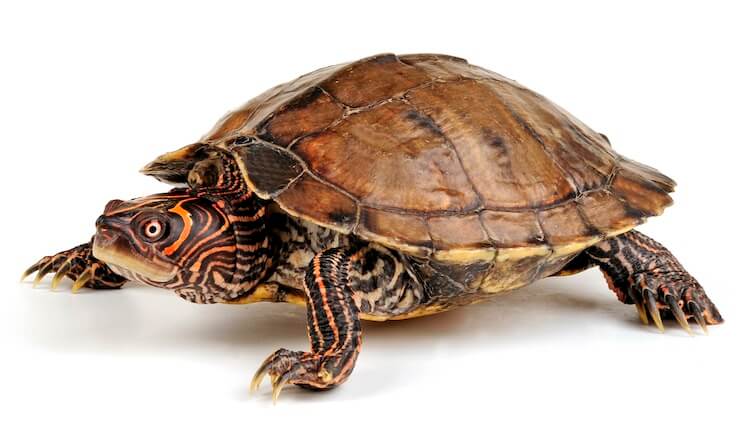
The False Map Turtle is related to the Mississippi Map (#12). They are both natives of the Mississippi River.
Unsurprisingly they are great swimmers and love to dive into deep water.
False Maps have a patterned skin that resembles a contour map. Their eyes are sometimes lighter in color which gives them the same surprised appearance as the Mississippi Map.
This breed should be kept in a 60-gallon tank with plenty of clean water and a basking area. They will spend most of their time basking.
They need frequent water filtering but otherwise are very easy to care for.
| Vital Facts |
|---|
| Price: $15 to $50 |
| Tank Size: 60-gallon |
| Size: 6 to 10 inches long |
| Lifespan: 35 years |
10. Midland Painted Turtle
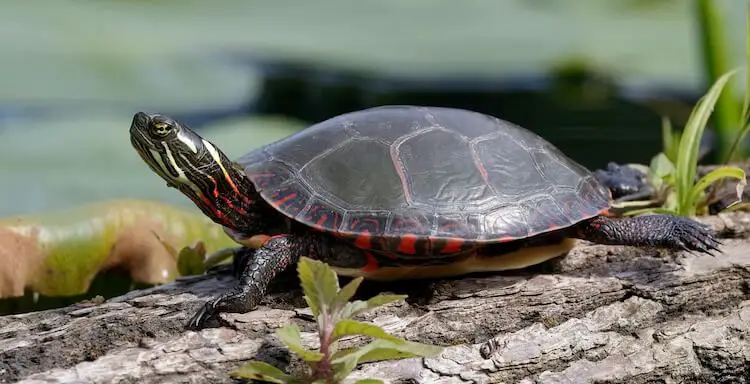
Painted turtles are great beginner turtles!
They are native to North America and have a range from southern Canada to northern Mexico. This subspecies is found specifically around the Great Lakes region.
Midland Painted species are popular for their bright colors and ease of care.
This is one of the most popular turtles in the world.
They are normally olive to dark green and patched, spotted and striped with bright red and yellow.
Midlanders are great beginner pets because they are hardy and tame.
They are quite happy to see their owners and generally do not retreat upon seeing them. They are also friendly with other types of turtles so you can have more than one.
Midlanders like slow-moving water with lots of vegetation and basking spots.
| Vital Facts |
|---|
| Price: $70 |
| Tank Size: 40-gallon |
| Size: 5 to 9 inches long |
| Lifespan: 35 to 40 years |
9. Southern Painted Turtle
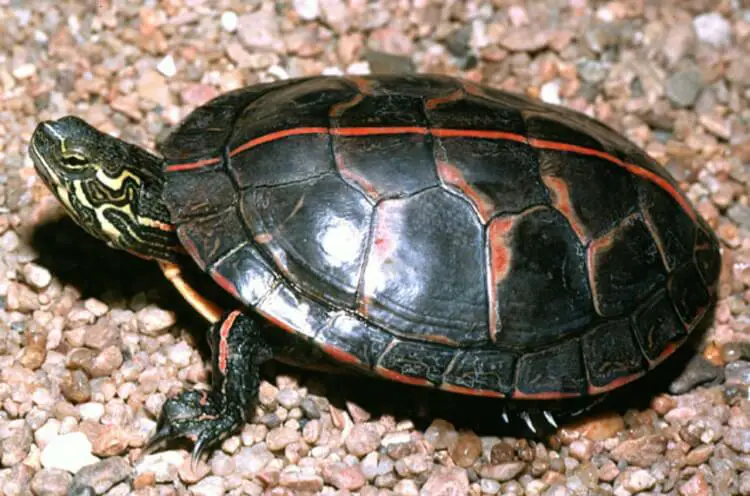
Southern Painted Turtles range from dark green to black and have a bright red dorsal stripe.
They are typically darker in color than Midlanders (#10) though they do share the same yellow-striped head.
Southerns are the smallest of the painted species. They make a perfect choice for someone who wants a small turtle.
They are normally found in the central United States (ranging from Illinois to Louisiana).
Southern Painted Turtles are known for being more tame and lower maintenance than other painted types.
| Vital Facts |
|---|
| Price: $75 to $150 |
| Tank Size: 40-gallon |
| Size: 4 to 6 inches long |
| Lifespan: 25 to 45 years |
8. Eastern Painted Turtle
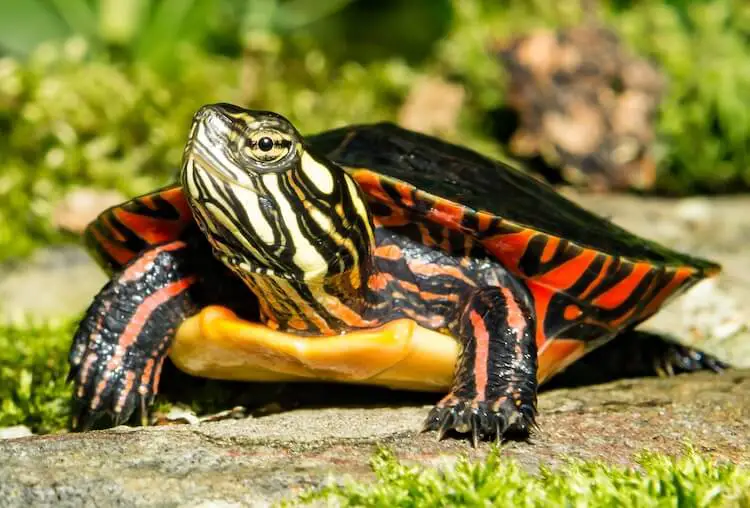
The Eastern Painted Turtle is similar in appearance to the Southern Painted (#9). Both share the same shell color but the Eastern has a yellow or red border. They sometimes have a red dorsal stripe like a Southern too.
This turtle can be found in New England, southeastern Canada and off the east coast of the US.
Because of their huge longitudinal range they are extremely hardy.
Like all painted species they adjust to captive life very well and are friendly.
| Vital Facts |
|---|
| Price: $70 to $130 |
| Tank Size: 40-gallon |
| Size: 5 to 7 inches long |
| Lifespan: 25 to 30 years |
7. Western Painted Turtle
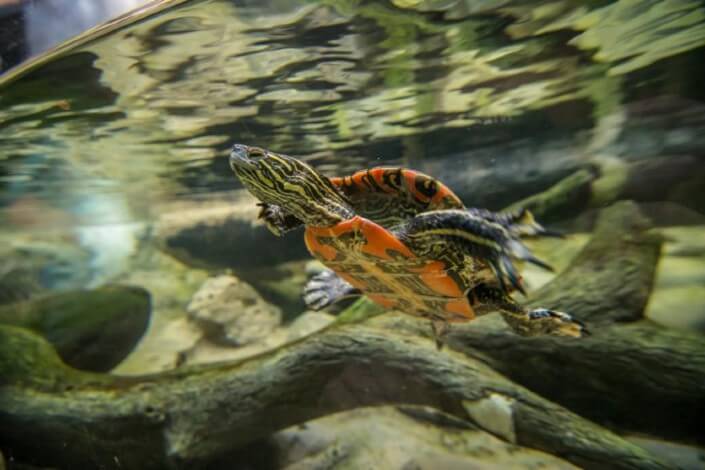
The Western Painted Turtle is the final Painted species on this list.
They are closest in appearance to the Midland Painted (#10) and often display bright yellow stripes on their heads and red-orange underbellies. They occasionally have a dorsal stripe but it is not as intensely colored as the Southern’s stripe (#9).
Their shells are olive to dark green.
Westerns are the largest type of painted turtle and are similar in size to the Slider (#1).
Their native range stretches across southern Canada to southern Missouri, eastern Colorado and northern Oregon.
Similar to other Painted types they are hardy and make a great low-maintenance pet.
| Vital Facts |
|---|
| Price: $70 to $130 |
| Tank Size: 125-gallon |
| Size: 10 inches long |
| Lifespan: 25 to 30 years |
6. Ornate Box Turtle
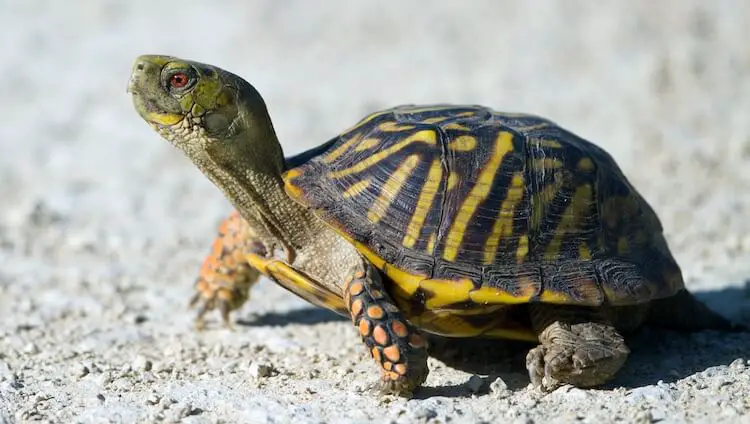
The Ornate Box Turtle is from the same family as the Desert Box (#26).
Ornates are less adapted to the dry environment of the Desert Box as they are from the central United States and not the Midwest.
Ornates are slightly more decorative than Desert Boxes despite having an overall less yellow hue:
- Their shells are dark brown with bright yellow stripes and spots.
- Their heads are yellow-green in color.
They have very similar care requirements to other box turtles and need water, a basking area, warm temperatures and a varied omnivorous diet.
Ornates can live for five decades and make great decorative turtles for someone who wants a lifelong pet.
| Vital Facts |
|---|
| Price: $45 to $300 |
| Tank Size: 125-gallon |
| Size: 5 to 7 inches long |
| Lifespan: 25 to 50 years |
5. Gulf Coast Box Turtle
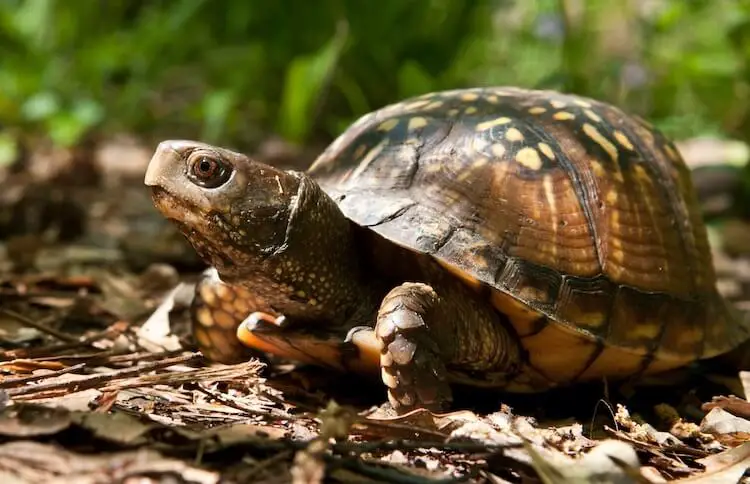
Gulf Coast Box Turtles are one of four subspecies of Terrapene Carolina. There are two more in this list (Three-Toed Box (#4) the Eastern Box (#3)).
This breed is usually brown and their shells have varying patterns of yellow or red.
Their dark brown heads tend to be spotted and they sometimes have red eyes.
Some types of turtles are fine being kept in a tank. This animal is not. It needs a large secure pen that is half in the sun and half in the shade.
Gulf Coast Boxes are difficult to care for.
This animal is good for beginners who want to learn about the complex care requirements of turtles.
They are naturally found along the North American gulf coast and Texas. Unfortunately they are often found outside their geographical range (e.g. central United States) as irresponsible owners release them in the wild.
Make sure that you are ready to keep a turtle before purchasing one.
| Vital Facts |
|---|
| Price: $100 to $400 |
| Tank Size: outdoor pen |
| Size: 8 inches long |
| Lifespan: 25 to 50 years |
4. Three-Toed Box Turtle
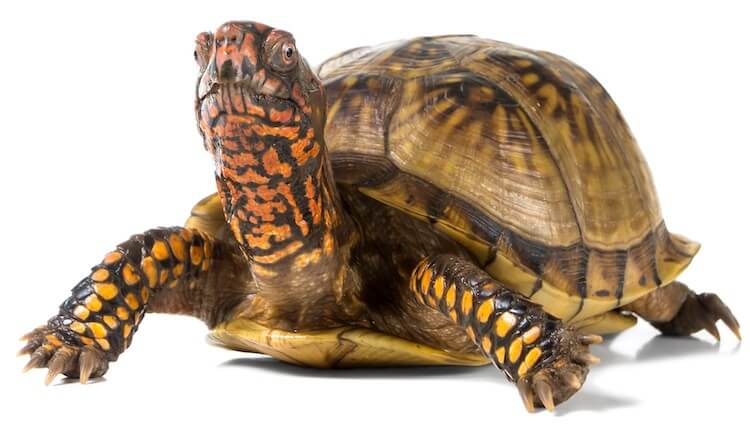
This species gets its name from its three toes on its hind legs.
Three-Toed Box Turtles are very similar to their Gulf Coast Box (#5) siblings. They are quite shy but can warm up to their owners after routine feeding.
A dedicated beginner can care for this pet.
This turtle is normally found along the Mississippi River Valley.
They can vary widely in color and have patterns of orange and red.
These turtles enjoy water more than their Box cousins (#3). You must provide them with shallow water where they can soak. They also like to dig. It is important that you provide them with an opportunity to dig without giving them an escape route!
| Vital Facts |
|---|
| Price: $40 to $100 |
| Tank Size: outdoor pen |
| Size: 4 to 11 inches long |
| Lifespan: 15 to 20 years |
3. Eastern Box Turtle
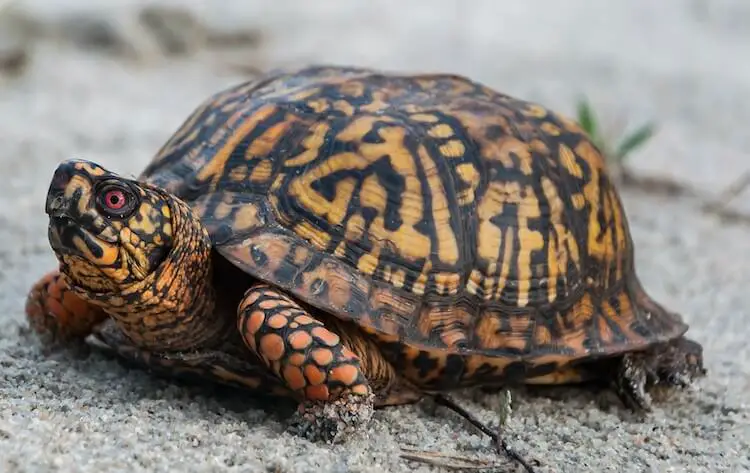
The Eastern Box is the most popular box turtle subspecies. This is because they are more adaptable to captive housing and are easy to buy.
They are generally patterned with brown, red and orange and come in many colors.
Eastern Box Turtles have four toes on their back feet – unlike their Three-Toed relatives (#4).
Like all box subspecies these guys do not enjoy frequent handling but they do have fun personalities.
Amazingly some Eastern Box Turtles have played with small toys with their keepers.
They are great for a beginner who is dedicated to learning about their nutritional needs.
| Vital Facts |
|---|
| Price: $50 to $400 |
| Tank Size:50-gallon |
| Size: 4 to 6 inches long |
| Lifespan: 25 to 50 years |
2. Yellow-Bellied Slider
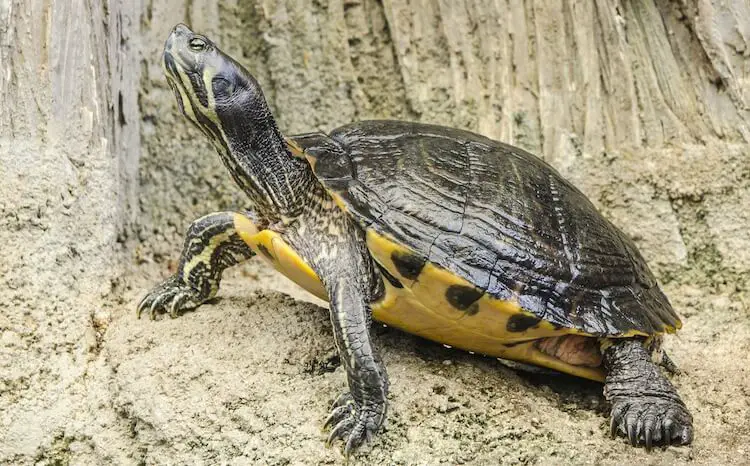
Sliders are one of the most popular pet turtles and fantastic for beginners. They are:
- Hardy.
- Easy to care for.
- Colorful.
- Entertaining.
Yellow-Bellied Sliders come in many different colors from green-yellow to gray. Some are even brown or black. Their bellies are usually solid yellow with black spots.
Their most striking features are the bold stripes that often line their head, neck and shell.
They spend their time foraging, basking and swimming and display unique personalities.
Yellow-Bellied Sliders are interesting and colorful turtles.
| Vital Facts |
|---|
| Price: $25 to $75 |
| Tank Size: 100-gallon |
| Size: 5 to 13 inches long |
| Lifespan: 30 to 40 years |
1. Red-Eared Slider
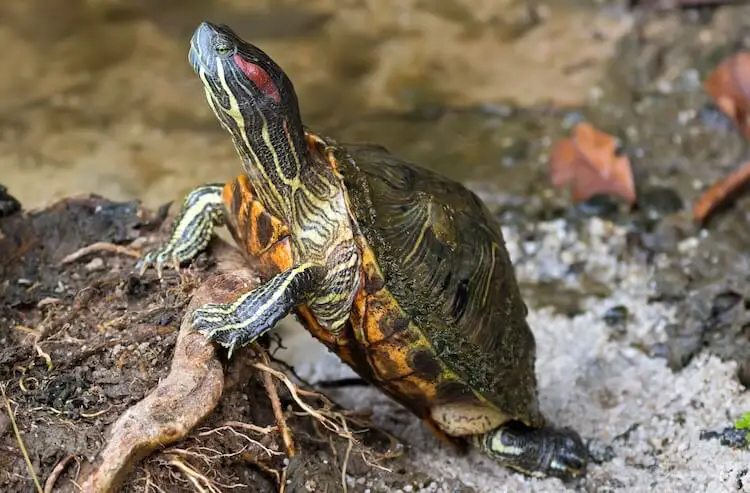
Red-Eared Sliders display bright yellow stripes on green or brown bodies.
The Red-Eared Slider is perhaps even more famous than their Yellow-Bellied (#2) sibling.
The main difference is that Red-Eared Sliders have red patches behind their eyes. This gives them their “red-eared” appearance. Their care requirements are the same as any slider species.
They need a large 120-gallon tank with plenty of light and water.
Though all turtles require work and dedication sliders are on the more hardy and low-maintenance side.
Red-Eared Sliders are brightly colored, easy to keep and make a great addition to any home.
| Vital Facts |
|---|
| Price: $20 to $30 |
| Tank Size: 125-gallon |
| Size: 12 inches long |
| Lifespan: 30 years |
Which Is The Best Turtle For You?
Turtles are incredibly unique pets. They provide lots of fun and teach any keeper about husbandry and responsible ownership.
Pet turtles require lots of time, care and attention!
There are many types of turtles and some species may suit your lifestyle better than others.
When choosing a turtle make sure you know how big they will grow.
Some small species include the Eastern Box, Southern Painted, Diamondback Terrapins, Spotted and Bog Turtles.
Some species like the European Pond, Midland Painted, Map and Reeve’s Turtles grow very big.
You should also research your turtle’s lifespan. Many live for 50 years!
If you cannot commit to a turtle for the entirety of its life you should not purchase it.
Species with shorter lifespans include the Loggerhead and Razorback Musks, Mata Matas, Florida Softshells and Red-Eared Sliders.
Good luck in your quest to find a turtle.
Feel free to read our turtle care sheets and let us know in the comments your favorite breed.

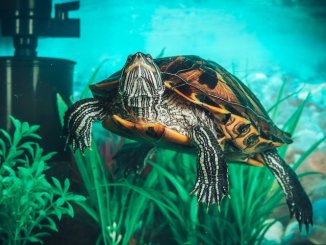
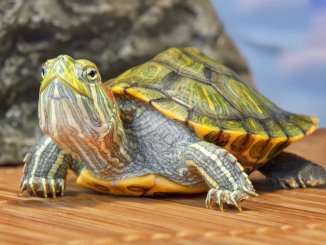
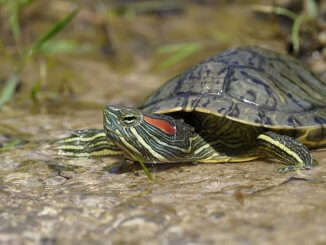

Please post the correct photos identifying the species.
Hi Peggy, the photos are now updated accordingly. Thanks.
I found a turtle but I am not able to find what kind of turtle it is like is it harmful or wild one or can I pet that turtle or not.can you help me out ?
What if I want to share the photographs to you,feel free to whatsapp me on 8875696552.Also I am from India!
None of these turtles are the one I have, but Im trying to figure out what my turtle is.
Is it a wild-caught animal? You might have a local species, or a rare pet species depending on where you’re from.